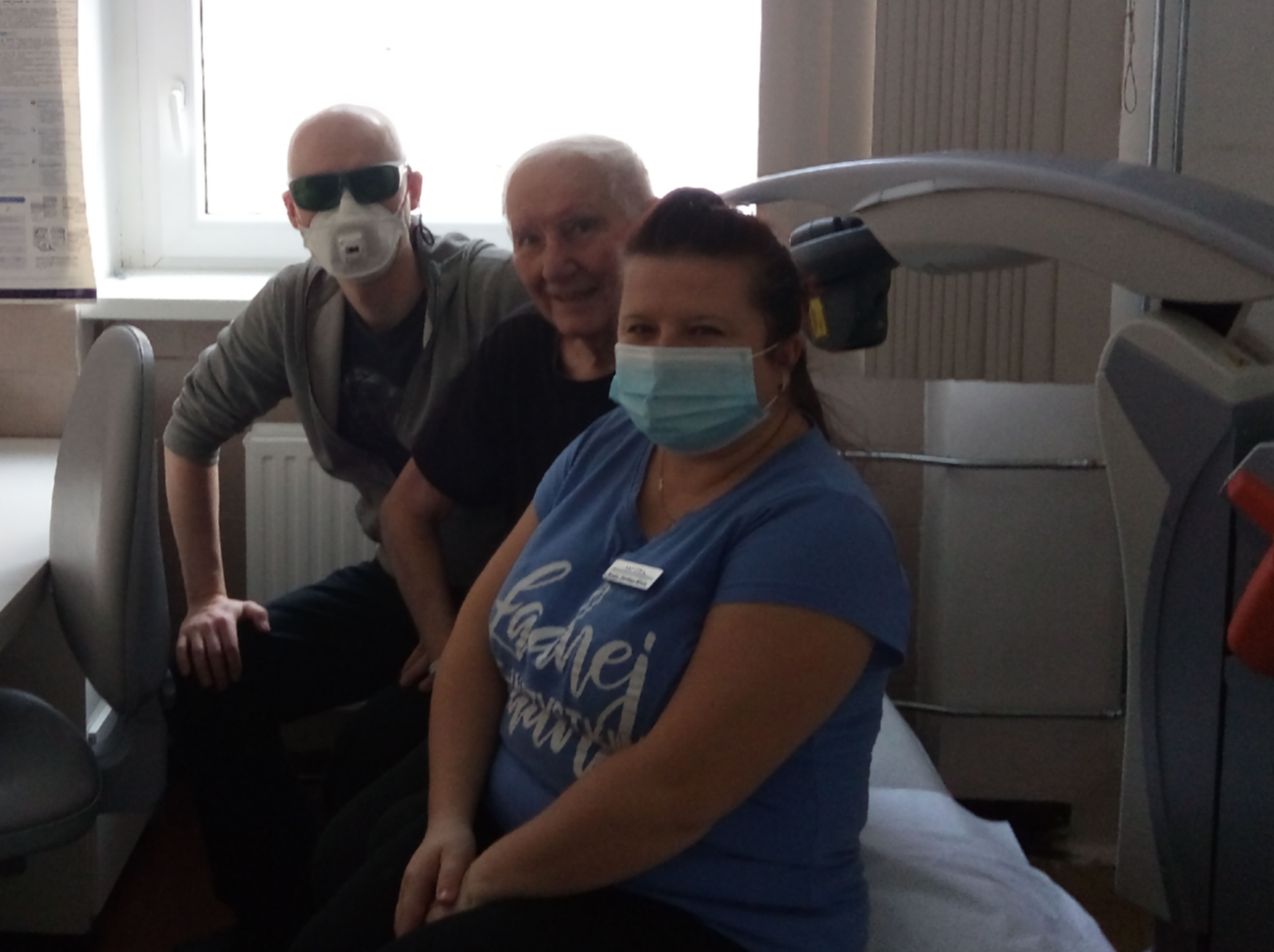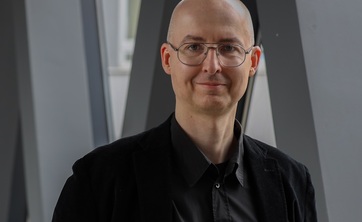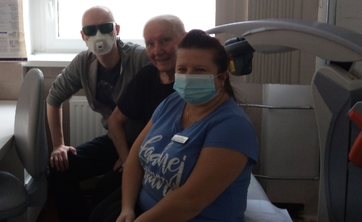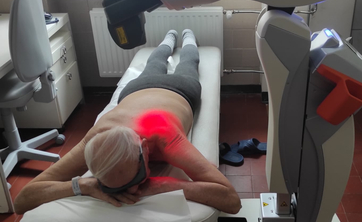Dr. Maciej Huk from our Faculty co-organized two research projects related to COVID-19. The first one investigated amantadine-based therapy, and the second – rehabilitation with the use of high-power pulsed infrared lasers.
Dr. Huk works at the Department of Applied Computer Science, where he performs research into artificial intelligence, including neural networks, as well as evolutionary and contextual systems. He is the author of international patents in this field and an editor in the scientific journals PLOS One and Evolving Systems. Over the the past two years, he has been involved in two important research projects related to the treatment of people suffering from COVID-19.
Amantadine investigated by specialists
The first of these projects is the nationwide TITAN clinical trial named "The effectiveness of amantadine-based COVID-19 treatment" carried out in cooperation with The Prof. Leszek Giec Upper Silesian Medical Centre at the Medical University of Silesia in Katowice, with the Polish Society of Lung Diseases, and with several hospitals in the entire country. The study received PLN 7 million from the Medical Research Agency.
– The TITAN study was a multi-centre, randomized, double-blind, in-hospital evaluation of the efficacy of amantadine in the treatment of COVID-19. The patients who qualified for the study received the so-called "standard of care" and placebo or amantadine in age-dependent doses and were observed for 28 days – says Dr. Maciej Huk, member of the scientific committee of the TITAN study. – Various additional examinations (morphology, ECG, X-ray) were also carried out as needed during the observation.
The plans called for testing up to 500 people with COVID-19 in the early moderate or in severe phase. The patients eligible for the study included those with SARS-CoV-2 infection confirmed by the PCR test and with a blood saturation (SaO2) at rest < 95%. One group was given the medicine and the other a placebo. The patients excluded from the study were those with comorbidities such as, but not limited to: clinically significant liver or kidney failure, epilepsy or seizures (current or history), psychiatric or somatic diseases, untreated closed-angle glaucoma, as well as pregnant women and people who used amantadine in the last 3 months before the study.
– Importantly, despite numerous difficulties caused by the pandemic situation, a binding result was obtained already after observations on 149 patients – says Dr. Huk. The results of the TITAN project were announced by the doctor leading the project, Prof. Adam Barczyk from the Medical University of Silesia in Katowice, together with the Medical Research Agency, which co-financed the project. The result indicates that the use of amantadine in the treatment of COVID-19 does not bring significant effects.
More information about this study can be found here.
The results obtained in the TITAN project were recently confirmed in another study, which was conducted in parallel by Prof. Konrad Rejdak from the Medical University of Lublin.
– It is worth emphasizing that in both studies, which were launched simultaneously, the key element was to possibly quickly verify the hypothesis about the effectiveness of amantadine in the treatment of COVID-19 – notes Dr. Huk. – Prof. Barczyk's team communicated the result to doctors and patients in a very short time, already in February 2022. In view of the obtained result, it was important to limit the scale of possible negative effects of incorrectly administered treatment (including the already reported complications due to amantadine in the form of induced hypothermia, characteristic neurological or cardiological disorders, and possibly trivializing the COVID-19 disease). It was possible owing to huge support of the Polish Society of Lung Diseases, led by Dr. Małgorzata Czajkowska-Malinowska, as well as of specialist doctors from many hospitals throughout the country, chemists, pharmacists, statisticians and other people involved in the project.
An article summarizing the results of the TITAN study has been submitted to the journal Respiratory Medicine and is currently under review: Barczyk, A., Czajkowska-Malinowska, M., Farnik, M., Barczyk, M., Wita, K., Huk, M., Skoczyński, Sz., et al. "Efficacy of oral amantadine among patients hospitalized with COVID-19: a randomised, double-blind, placebo-controlled, multicentre study", submitted on 25 November, 2022.
Laser pulses in the fight against complications after COVID-19
The second project organized by Dr. Huk concerned the use of high-power pulsed infrared lasers to support the rehabilitation of patients after COVID-19. It involved about 40 people of both sexes who experienced COVID-19 and showed complications from the respiratory, cardiovascular and muscular systems. The age range was very wide – the oldest participant was 83 years old.
The study was an attempt to test an innovative rehabilitation method for patients recovering from COVID-19. Before the tests in Poland, it was already ivestigated among others in the U.S. and in the Czech Republic. The procedures consisted in irradiating the patient's lungs, exposed while the patient was lying in a special position (on the stomach).

– In each of the five sessions, the patient's lungs were irradiated for 15 minutes (7.5 minutes per each lung). An appropriate dose of energy was transmitted by a pulsed, 75 W deep-infrared laser placed on a robotic arm (ASA laser M8) – explains Dr. Huk. – The energy was evenly distributed in a large volume of tissues, and these were still protected against destruction owing to the pulsed operation of the laser head and its continuous movement over the patient's body. It is worth to know that lasers of such power are used in industry e.g. for cutting and engraving gold and steel jewelry. During the procedure, the robot received data on the radiation dose, the working time and an indication of where the patient's lungs were, and then moved and irradiated the examined person. The staff left the room for the time of the procedure. After a period of time, the robot automatically turned off and the radiation process stopped.
The expected result of this procedure is to increase the production of ATP molecules in the mitochondria of cells, independently of the aerobic Krebs cycle. The energy thus supplied can be used by the patient's body, e.g. for tissue regeneration processes. In part, this can be compared to the beneficial effects that people get by sunbathing on the beach – but the tan is not the goal here. However, there is an additional anaesthetic effect supporting rehabilitation.
Dr. Maciej Huk organized laser pulse rehabilitation in the pulmonary wards of several hospitals, including ZOZ Głuchołazy. He also helped train the staff and worked as a volunteer during this study.
– The attempt would not be possible without the support of ASA Laser and Meden Inmed companies as well as members of an interdisciplinary team that analysed the safety and impact of infrared laser radiation on the human body. – A particularly significant contribution was made by: Dr. Łukasz Boda (a researcher from the Jagiellonian University, Kraków, who specialises in applications of infrared lasers in biomolecular chemistry), Dr. Monika Słaboń-Willand (an anaesthesiologist from The Prof. E. Michałkowski Specialist Hospital in Katowice), MSc Ph. Sylwia Kotecka (Apteka Wielkopolska in Poznań; a specialist in pharmacokinetics and drug interactions).
Although there was not enough time and financial resources for further observations, it can be said already at this stage to be a promising project and definitely worth further research.
– From my perspective, the procedures had a beneficial effect on patients – says Dr. Maciej Huk. – An example is an 83-year-old patient who went through COVID 19 very hard and came close to death. During three months of illness in a closed COVID ward, he lost about 30% of his body weight (including muscles), and his respiratory capacity was limited by 95%. He also lost hope that he would survive. Before the irradiation procedure, during rehabilitation in ZOZ Głuchołazy, he was unable to independently walk 45 meters without a long rest (as with very severe sarcopenia). He briskly walked three times that distance already after the first session. This should not be surprising – many independent studies have shown that access to light is very important for the functioning of the human body. And even if it was just a placebo effect, it could also have a positive impact on the recovery process. This is because the psychological aspect – raising hope for a cure and the determination to continue rehabilitation (and this was the case here) – cannot be overestimated. To this day, two years after the procedures, the patient is doing well, works and drives a car.


